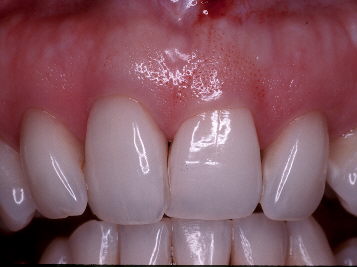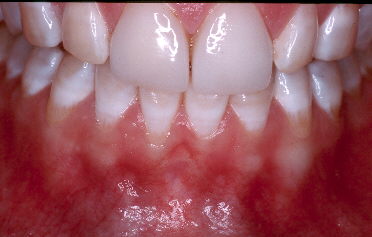Forums › Laser Treatment Tips and Techniques › Soft Tissue Procedures › Two Laser Frenectomy Cases
- This topic is empty.
-
AuthorPosts
-
Dan MelkerSpectatorJeff,
I cannot tell from the picutre but if the patient has adequate connective tissue which is attached then a GV with a laser would definately work.
Notice I keep saying connective tissue which is attached to root surface or bone. That is the only way to get away with GV.
Thanks,
Danny
AnonymousGuestQUOTEQuote: from Dan Melker on 7:01 pm on April 25, 2004
Ron,
No question the problem was caused by labial position of the tooth as well as possible secondary occlusal trauma.
DannyOcclusion could be adjusted but if the position of the tooth isn’t altered would you get a repeat after the graft?
Dan MelkerSpectatorNo,
Ron again having treated 100’s of cases over the years and seeing no relapse, the graft will absolutely protect the underlying bone. There are many other Periodontists like myself that have done these procedures for years with exactly the same results.
I can show you at nausium successful long term results, why wouldn’t we want to put back what was lost.
As I sai d in another thread-if you could put a finger that was lost back would you? of course.
If you could put back attached connective that was lost would you? of course
There is no more conservative procedure then putting back something that was lost!
Danny(Edited by Dan Melker at 7:48 pm on April 25, 2004)
BenchwmerSpectatorDan,
Here is a better pre treatment photo of #9.
Jeff
Dan MelkerSpectatorJeff,
I would agree from what you have said that a GV with a laser would be successful. I do not do GV’s but I have never used a laser either.
There is the appearrance of a shorter incisal edge on #9. Always makes me wonder if the bone heights are different.
Please do your trt. so we can follow it. It should be very successful and with the laser free from discomfort.
Thanks for the followup
Danny
Glenn van AsSpectatorHey Jeff, I would do a little on the left lateral as well as the central. Interesting thread. Jeff you said something really bang on and that was how the approach for taking of tissue really varies depending on erbium vs soft tissue (diode or ndyag or CO2)
The erbium should be parallel to the tooth unless you dont go all the way through the tissue. The soft tissue lasers can be perpendicular in their approach as you dont have to worry about iatrogenic notching of cementum, enamel and root.
I actually like the erbium for alot of these gingivectomies if you keep the energy low enough (it takes a little longer than if you pump up the erbium energies though)
Wouldnt it be cool to see an erbium laser capable of 50-60 Hz……I bet that would be smooth on soft tissue………hmmmmm.
Nice thread
Glenn
Dan MelkerSpectatorJeff,
I would love to see a follow up of this case. I am sure you have pictures months down the road. Would love to see them.
Thanks,
Danny(Edited by Dan Melker at 8:30 am on June 17, 2004)
BenchwmerSpectatorLower frenectomy at 6-month recall, 4+ months after Erbium laser frenectomy.

Jeff
Andrew GerberSpectatorJeff,
Excellent clincal skill and commentary. Considering you possess an OpusDuo, why did you choose to use the ErYag and not the CO2 for your frenectomy.Warm regards
Andrew Gerber
Gerber Dental Group
Brisbane
Australia
Glenn van AsSpectatorHey Andrew……..I am coming down to Australia in the next month (October ) to lecture in Sydney and most likely Melbourne and the Gold Coast.
How has the weather been and what temps will I be likely to encounter in the middle to end of October.
Thanks
Glenn
Dan MelkerSpectatorJeff,
The frenectomy looks great. I still feel that a sub-epithelial graft is warranted on #25. You have reversed the slide. You have approx. 2mm. of recession in a young patient. If you probe #25 you will see you probe to the mucogingival junction-in essence no attached giniva + recession +young patient= SECTG.
Again, agreat case of correction of fenum pull but that has not solved the lack of AG on #25
Thanks for listening,
Danny
BenchwmerSpectatorAndrew,
I also have a PerioLase Nd:YAG so when purchasing a “hard tissue” laser, I couldn’t imagine what I would use a CO2 laser for, so I only purchased an OpusDuo Erbium. The same OpusDuo case, but only the Erbium laser in it.
After two years I don’t miss having the CO2.
Jeff
BenchwmerSpectatorDan,
Thinking about you yesterday.
New patient 6 months ago, 30 year old had bright red gingiva around single crown #9. I treated the inflamtion with the Nd:YAG, but saw him yesterday and now it’s back.
A definate BW violation. I’ll catch a photo next week. Told him time for a crown lengthening surgery to allow for BW and even out the gingival margin on #8.
I’ll post it in the consult forum.
Jeff
ELLIOT ROGOFFSpectatorJeff, the two cases using the erbium and nd-yag were very nicely done. I have also used the CO2 laser for this and have also had nice results. It is getting more apparent to me that the type of laser is not the most important thing – it appears to be the understanding of these tools. I was also curious to know that with the use of the Opus Duo you used 500mj and 12 hz and this to me equals 6watts. But you tested this on the power meter and it read 2 watts. I have been trying to understand the other lasers on this post so I can compare apples to apples. Do you think I should invest in a power meter and should all of us give perhaps more accurate power settings? Thanks for all your sharing. Elliot
BenchwmerSpectatorHey Elliott,
The OpusDuo uses a hollow wave guide, a contra-angle handpiece w/ a mirror and then a sapphire tip. By the time power gets to the tip there is a loss of 2/3 of laser energy.
I routinely use a power meter, when I test fire my Nd:YAG, then recleave the fiber or adjust power to get my desired power at the tip.
With the Erbium, since I use a water spray for most procedures, I test fire into a plastic cup, to insure water spray. I change settings during my Erbium procedures to attain the desired results.
Laser type may not matter when ablating tissue, but that is not true in Perio therapy or removing minute amounts of tissue (ex. near papillas). The zone of tissue necrosis is a variable and somewhat dependent on laser type, as well as amount of energy.
I couldn’t and wouldn’t use the Nd:YAG w/o knowing the actual tip output. I have used Nd:YAG lasers with output off 20%. My machine setting at 3.0W would be 2.4W on one machine, 3.6W on another. I’m glad I knew the true output.
Jeff -
AuthorPosts
